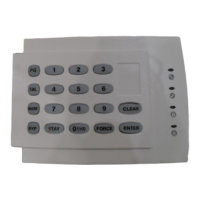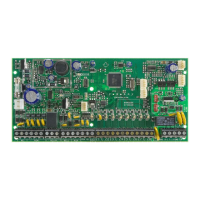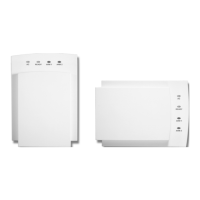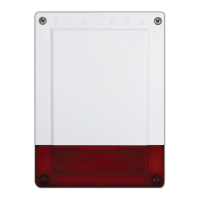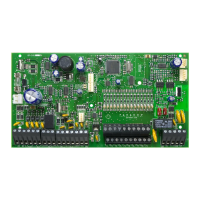Magellan & Spectra SP • Installation Guide
33
Auto Zone Shutdown
Sections [001] to [032] = Zones 1 to 32
Option [1] OFF= Auto Zone Shutdown Disabled
Option [1] ON= Auto Zone Shutdown Enabled for selected zone (default)
If, in a single armed period, the number of alarms generated by a zone with the Auto Zone Shutdown option enabled exceeds the number defined by the Auto Zone
Shutdown Counter, the control panel will no longer generate an alarm for that zone. To program the Auto Zone Shutdown Counter, key in the desired limit
(000=Disabled, 001 to 015, Default = 5) into section [712]. The Auto Zone Shutdown Counter resets every time a valid code is entered.
Bypassable Zones
Sections [001] to [032] = Zones 1 to 32
Option [2] OFF= Bypass Zone Disabled
Option [2] ON= Selected Zone is Bypass Enabled (default)
When a user utilizes the Bypass Programming feature (See “Bypass Programming” on page 27), only zones with the Bypass option enabled can be programmed as
bypassed.
Do not program a fire zone with the Bypass option, as the control panel will never bypass fire zones.
RF Zone Supervision
Sections [001] to [032]: Zones 1 to 32
Option [3] OFF= RF Zone Supervision Disabled
Option [3] ON= RF Zone Supervision Enabled (default)
The panel waits for each of its assigned wireless transmitters to send a status signal within a specified time period (section [706], option [1]) to confirm their
presence and functionality. If a device has not sent a signal within that time period, the control panel can generate a trouble, an alarm, and/or transmit a report code
to the monitoring station. See Trouble Display on page 63.
Alarm Types
Sections [001] to [032]: Zones 1 to 32
[4] OFF / [5] OFF: Audible Steady (default)
When the conditions for an alarm have been met, the control panel can transmit the appropriate Zone Alarm report code and provides a steady output for any bells
or sirens connected to the control panel’s bell output.
[4] OFF / [5] ON: Audible Pulsed Alarm
When the conditions for an alarm have been met, the control panel can transmit the appropriate Zone Alarm report code and provides a pulsed output (see Figure
9 on page 30) for any bells or sirens connected to the control panel’s bell output.
[4] ON / [5] OFF: Silent Alarm
When the conditions for an alarm are met, the control panel can transmit the appropriate Zone Alarm report code and will not activate the control panel’s bell
output. The appropriate
ARM or STATUS LED on the keypads will flash to indicate an alarm and the user will still have to disarm the system.
[4] ON / [5] ON: Report Only
When the conditions for an alarm have been met, the control panel can transmit the appropriate Zone Alarm report code. The system will not have to be disarmed.
Intellizone
Sections [001] to [032]: Zones 1 to 32
Option [6] OFF= Intellizone Disabled (default)
Option [6] ON= Intellizone Enabled for Selected Zone
This feature reduces the possibility of false alarms. When a zone with the Intellizone option opens, the panel does not immediately generate an alarm. First it
triggers the Intellizone Delay Timer. To program the Intellizone Delay Timer, key in the desired 3-digit value (000 to 255 seconds, Default = 48 seconds) into section
[713]. If any of the following conditions occur during this period, the panel will generate an alarm:
• During the Intellizone Delay, a second zone has caused an alarm.
• During the Intellizone Delay, the zone in alarm has restored (closed) and re-occurred (opened).
• The zone in alarm remains open for the entire Intellizone Delay.
Delay Alarm Transmission
Sections [001] to [032]: Zones 1 to 32
Option [7] OFF= Delay Alarm Transmission Disabled (default)
Option [7] ON= Delay Alarm Transmission Enabled for Selected Zone
When an alarm condition occurs on a zone with this option enabled, the control panel enables the bell/siren output, but does not report the alarm to the
monitoring station until the end of the Delay Alarm Transmission. To program the Delay Alarm Transmission, key in the desired 3-digit delay value (000 = Disabled,
001 to 255 seconds) into section [833]. During this period, disarming the system disables the bell/siren output and cancels the report code transmission. This
feature is commonly used with entry delay zones to reduce false alarms created by new users who may not disarm the system in time.

